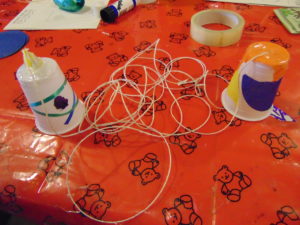In the wake of the very enjoyable ‘Old Science Week’ at Lotherton Hall last week, I’ve been thinking about how it went. I was there for the Monday and the Wednesday, which you can read about here and here respectively.

Working with Lotherton Hall on this event meant that we were able to use the usual setting for family activities at the house. This is the Servants’ Hall, a great adaptable space which can accommodate large groups of adults and children, and allow for all sorts of interaction, engagement and creativity. The week fitted into Lotherton Hall’s “Six Weeks of Summer” programme, a series of themed weeks aimed at school aged children during the summer holidays. As such, a handling table and arts and crafts related to the theme and collections were on offer. Some of the objects on display for handling, old electrical domestic appliances, as pictured here, were borrowed from Artemis, Leeds City Council’s artefacts loan service.
Although Lotherton’s themed weeks are largely for younger children, we knew our engagement would be with visitors of all ages, some as part of a family and some alone or with friends. Thus the best format for the activities – in line with other crafts activities held in this space – was a series of drop in sessions which people could join and leave as they wished. This wouldn’t tie them into being there at any particular time or require them to participate in anything too structured or formalised. As Dee Matthews, Lotherton’s Learning Officer, later observed, the end of the summer holidays begins to quieten down; it was thus easier to engage with visitors for longer periods, and to encourage them to think about what each object was and how it was used. Relating this to electrical appliances and gadgets in their own homes was also very effective.
One of the decisions we needed to make when thinking about how best to run these activities was whether or not to include any written interpretation. We considered for example a fact sheet about the history of electricity, or domestic lighting at Lotherton, but Dee recommended that it wouldn’t be appropriate for the setting. It also might look as though we were trying to create too formal a learning environment, but with various craft activities and object handling there was plenty on offer to keep the visitors interested.

Instead we decided that it would be best simply for me to talk to those adults who were interested to find out more about the topic and about the work of the project. This I did on a couple of occasions. We also included a sign next to the handling objects which explained why they were there, invited people to pick them up, and asked a couple of simple questions aimed at the children.
However, in hindsight, I think there may have been an advantage to having a simple interpretation sheet near the objects for the benefit of adults without children coming into the area. This would have supplemented the information given on the sign and provided them with more context and information about Old Science Week. It would also have meant that these visitors would still have gained something from the display when Dee and I were unable to speak with them, for example because we were busy talking to or working with the families.
Overall I thoroughly enjoyed the time I spent at Lotherton, talking to the families and adult visitors, and I think our ‘Old Science Week’ activities provide a good model for running such events in future. However, I would bear in mind a few points where we could improve on the event.
- If possible it would help to have two people from the university; it might not always be possible for the house staff to be present, so in order to make the most of all of the visitors, and talk to as many people of different age groups as possible, it would help to have two people able to give personal interpretation present consistently over the course of the day. This would also help with taking photographs of the event, something which I found it challenging to fit in as I was busy speaking with people, and to have stopped and taken photographs would more often than not have interrupted the flow, spoiled the atmosphere, and lost the interest and attention of the children.
- It may seem an obvious point, but university attendees should have some sort of identifying badge to wear; I had nothing at the beginning and I felt the difference it made.
- As mentioned above, I think a page of written interpretation aimed at the adult visitors who passed through the Servants’ Hall over the course of the week would have been helpful. It would not have been long, but would have added some depth and context to the objects on display, and to the theme of the week more generally.

Please leave any comments below; if you came along one day last week, we’d like to hear what you thought of it, and if you’re thinking of doing something similar to this in another country house then please get in touch!






